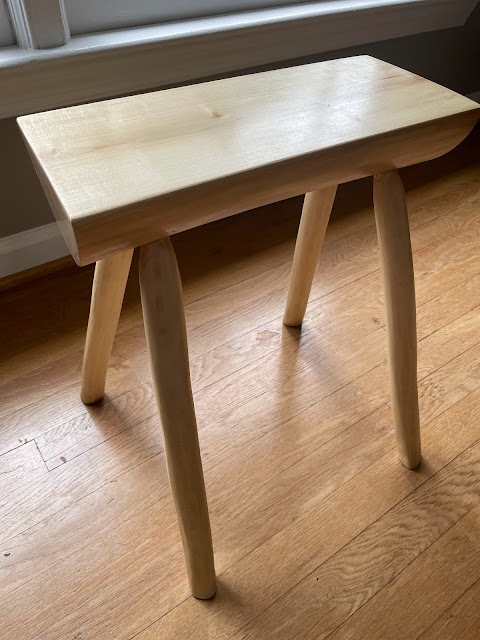Live edge tables seem to be everywhere. For good reason in my opinion, as they showcase the grain, character and variations of an entire slice of a tree. But that means that someone has to anticipate and arrange for that slice to happen.
I was fortunate that our nephew Matt did just that when he had a chestnut oak taken down. An outfit from Pennsylvania took the tree, milled it into slabs, and stacked and seasoned it for three years. Matt's dad, my brother-in-law David, received several pieces and made some beautiful tables from them. And he generously asked if I'd like a piece too. Yes I would.
 |
| Live edge chestnut oak table |
Challenges arose, as they always do. There were several knots and wormholes to be filled, some of which went all the way through the slab. On YouTube the makers just tape up the holes on the underside, pour in epoxy, let it set and hey presto! Done! It didn't work that way for me.
It was my first experience with epoxy. I chose the 4-hour setting type, thinking I didn't want to rush. I taped up the holes on the bottom as well as I could, and I put some filler sawdust and super glue into the holes to help fill them. Then I spooned in the epoxy, waited while it seeped into the crevices, spooned in more...and more...where is it all going? Next day I turned the slab over and saw a large layer of epoxy under the tape I'd so carefully applied. All I could think of was how long it would take to remove all that.
That process was repeated several times until I had successfully plugged everything and removed all the excess. It took about forever.
Other factors were more tractable. David showed me how he used wood hardener to solidify some of the rotted or soft wood at the edges. It worked well and saved a lot of time cleaning. And it preserved some nice character too.
The wood grain is quite porous in places, and several coats of polyurethane didn't quite smooth it out, but I'm okay with the surface. It's rustic, right? And there are so many other interesting things to see on the top.
The legs are pretty simple: 28-inch hairpin steel legs right out of the box. It takes two people to get the positions right, one to lift the 37 pound top and the other to tweak and mark the legs once positioned. Then it's just three screws per leg (I didn't inset the mounting plates into the table) and it's done.


.jpg)
.jpg)





.jpg)
.jpg)







